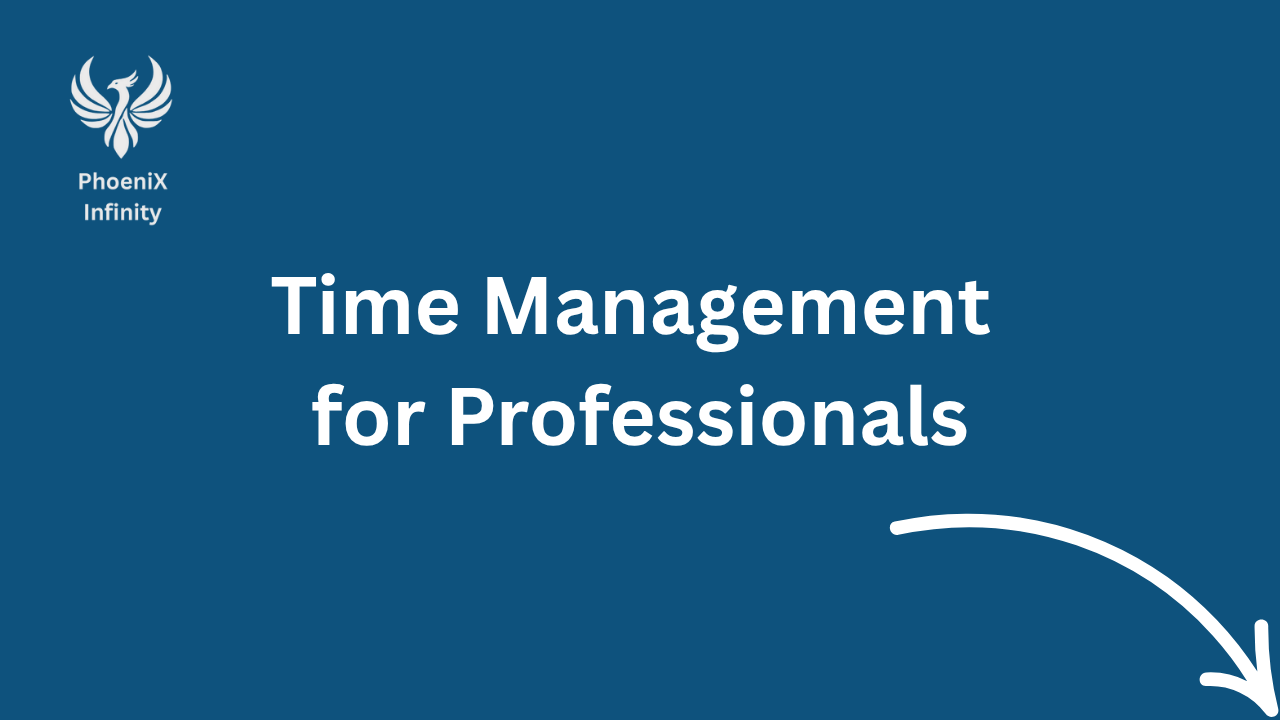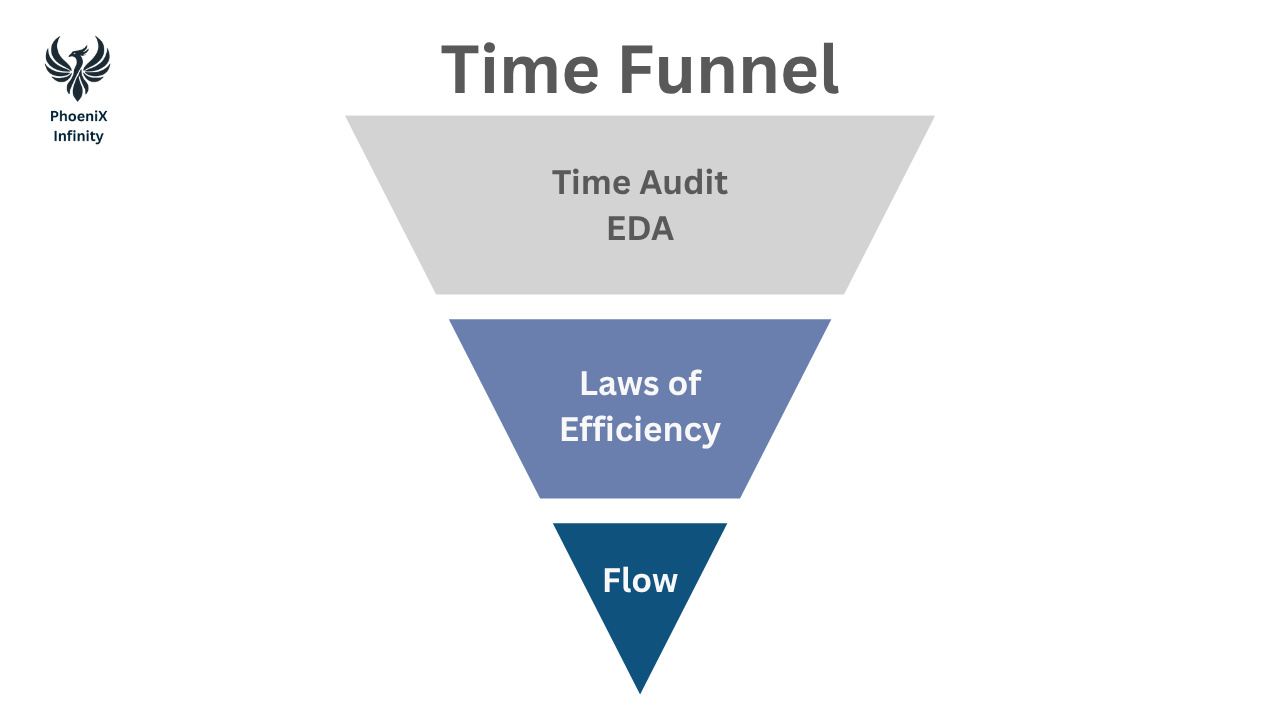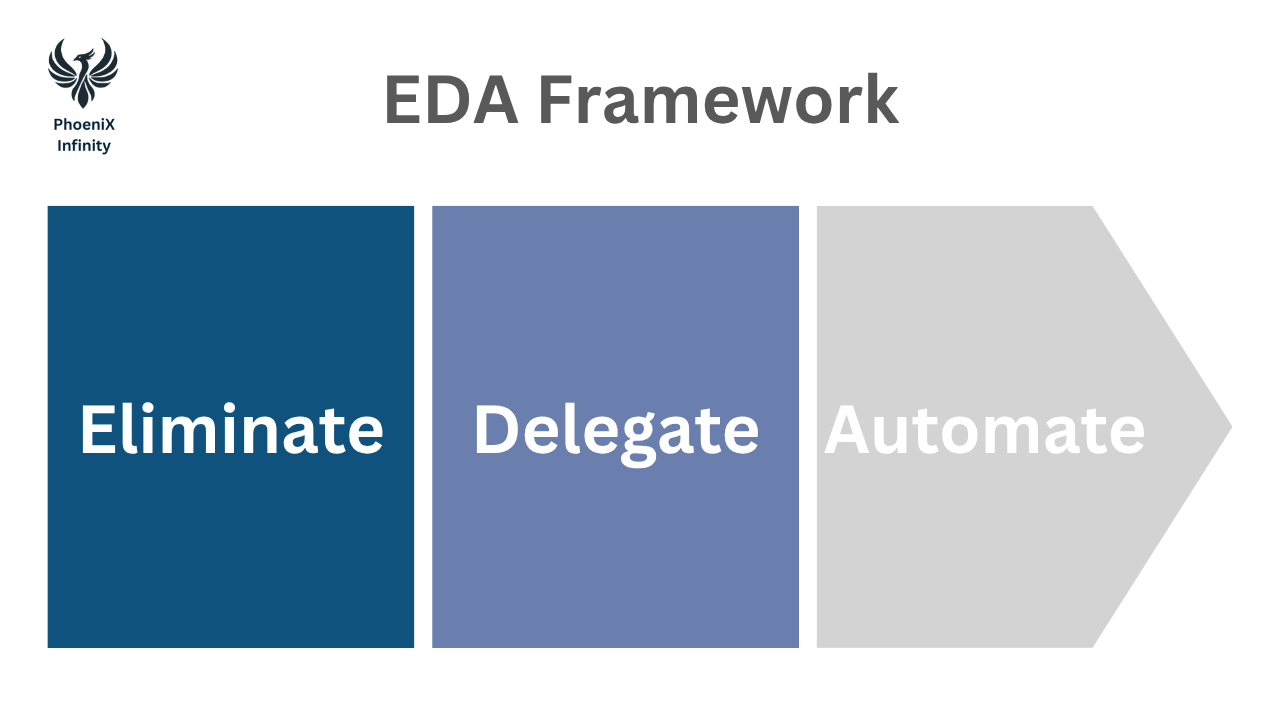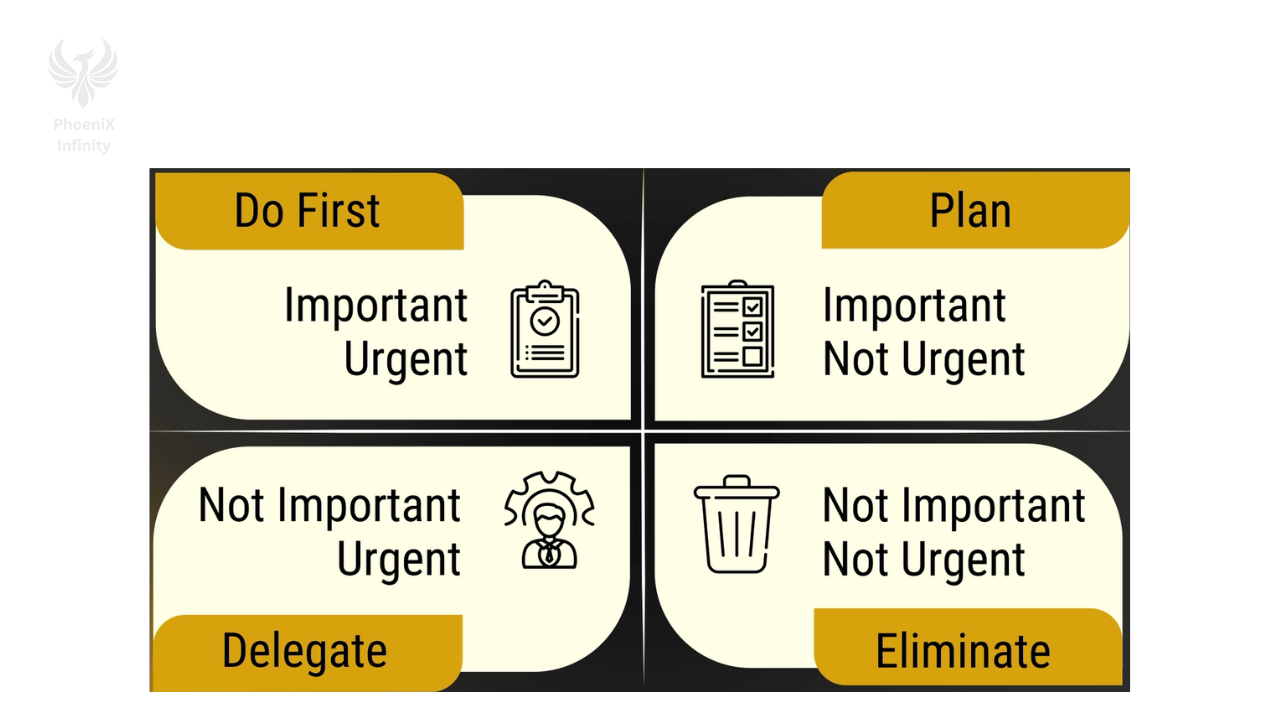Time Management for Business Professionals
Nov 07, 2025
Why It Feels Like Time Is Always Winning
Time and energy are your most valuable resources, yet most weeks feel like a sprint you didn’t sign up for. You start Monday with a plan, and by Wednesday your calendar is a patchwork of meetings, urgent pings, and half-finished tasks. You push later into the evening to “catch up,” only to begin the cycle again the next day. The harder you try to outrun the chaos, the more out of control it feels.
Here’s a different way to look at it: time management isn’t about cramming more into your day. It’s about designing a system that protects your attention for what matters most and then letting that system run, week after week.
Use Timeless Laws, Not Hacks
You don’t need the latest productivity app or a color-coded calendar to reclaim your week. What you need is a small set of timeless laws that govern how work actually gets done and a way to apply them in the right order. In this article, you’ll build a funnel you can use every week:
- EDA + Time Audit to remove waste at the source
- Three Laws of Efficiency (Pareto, Eisenhower, Parkinson + Batching) to focus and speed up
- Time Multipliers to invest once and save time repeatedly
Run this funnel and you’ll produce the same outcome, reliably: more meaningful work, fewer emergencies, and clearer evenings.

Step 1: EDA + Time Audit – Simplify Before You Optimize
Before you try to be faster, make sure you’re not sprinting in the wrong direction. Eliminate-Delegate-Automate (EDA) is the foundation of time management for professionals because it deals with workload quality, not just personal speed.
Eliminate what doesn’t matter.
Outgrown reports, vanity metrics, standing meetings with no agenda; if they vanished tomorrow, who would notice? Run a two-week Time Audit (a simple log in Notes or a spreadsheet). Tag each task with impact and frequency. Anything low-impact and frequent is prime for elimination. If you’re unsure, test a two-week stop and see if anyone asks.
Delegate what doesn’t require your edge.
If someone can do a task 80% as well, let them own it and coach the final 20%. Delegation is not abdication, it’s focus. Your job isn’t to hoard tasks; it’s to spend time on work only you can do: decisions, design, strategy, relationships.
Automate the repeatable.
Calendar scheduling, status reminders, expense rules, data refreshes, anything with a pattern can be templatized or automated. Start simple: email templates, checklists, clean handover docs. When a task repeats three times, ask:
What would the checklist or script look like?
Run the audit, then apply EDA.
Audit one week. Sort tasks into Eliminate / Delegate / Automate / Keep. Book the conversations and build the templates. Don’t get trigger-happy; be responsible, especially with compliance or client-facing work. If in doubt, align with your manager: “Here’s where my time goes; here’s what I propose to stop, hand over, or automate and how it supports our goals.”

Step 2: The Three Laws of Efficiency (and Their Result)
Once you’ve stripped out the noise, the question becomes simple: where should your best hours go? Three classic laws: Pareto, Parkinson, and Batching give you a calm, repeatable way to decide. Think of them as lenses you look through in sequence: first, find the few things that truly matter; second, sort everything by importance instead of adrenaline; third, contain the work and group it so your brain can stay locked in.
Law 1: Pareto Principle: Find the Vital Few
If you quietly examine your last month, you’ll probably notice a pattern: a tiny set of efforts created most of your progress. That’s Pareto in action. The purpose of this lens isn’t to sound clever; it’s to name, in plain language, the two or three outcomes that would make this week a win even if everything else slipped.
Start by dumping every open loop onto one page: projects, pings, promises, “shoulds.”
Now, ask the hard questions:
Which outcomes would meaningfully move revenue, reduce risk, create strategic clarity, or strengthen trust with the people who matter?
Circle only those. The rest can wait, shrink, or vanish. When you commit your best hours to the circled outcomes, you stop chasing motion and start compounding momentum. This is not theory; it’s prioritization with teeth.
Eisenhower Matrix: Prioritize by Importance, Not Noise
Urgency is loud; importance is quiet. The Eisenhower Matrix helps you hear the quiet voice.
- Q1: Urgent + Important: Do first. True deadlines, real consequences.
- Q2: Not Urgent + Important: Plan. Strategy, relationships, health, learning.
- Q3: Urgent + Not Important: Delegate. Someone else’s urgency, low-impact pings.
- Q4: Not Urgent + Not Important: Eliminate. Distractions and time-wasters.
Most professionals spend too much time ricocheting between Q1 and Q3, always “busy,” rarely grounded. The shift is to live in Q2 on purpose. Practically, that means taking your circled Pareto outcomes and blocking real time for them before anything else. It also means pushing Q3 into EDA–delegating interruptions, saying no where possible, and setting expectations. And it means cutting Q4 without guilt. When you invest in Q2 consistently, Q1 gets smaller and calmer, because you planned the work before it exploded.

Law 2: Parkinson’s Law – Ship a V1 in a Tight, Honest Window
Give a task the whole afternoon and it will happily expand to fill it. That’s Parkinson’s Law. The fix is a time-boxed V1: set a shorter, realistic window and commit to producing a first version by the end of it. Perfectionism hates clocks; outcomes love them. Replace “work on strategy” with “draft 1-page strategy outline, 45 minutes.” When the timer starts, you’re not aiming for perfect, you’re aiming for visible and reviewable. A rough outline can be refined, shared, or redirected; a blank page can’t. If the work truly needs more time, you can give it another box, after you’ve shipped something that moves the ball. Over a week, a handful of tight V1s will outrun one sprawling “final” every time.
Law 3: Batching – Protect Your Focus by Grouping Like With Like
Most days leak energy not because the work is hard, but because the switching is. You’re deep in a model, a messenger ping hits you into a thread, a calendar alert drags you into a status call, and by the time you return to the model you’ve lost the plot. Batching is how you stop the leak. Group similar tasks into single-purpose windows so your brain can stay in one “gear” at a time. Make communication predictable: two short “lanes” for email and chat (late morning and late afternoon) instead of nibbling all day. Cluster meetings into one or two heavier blocks so at least one day each week stays meeting-light. Theme your remaining work blocks: analysis-only, writing-only, outreach-only. The goal isn’t rigidity; it’s rhythm. When your calendar has clear valleys for admin and wide plateaus for deep work, you recover the cognitive fuel that context switching burns.
Flow: Engineer the Conditions for Deep, Satisfying Work
Flow isn’t magic; it’s design. It shows up when three things align: a meaningful challenge, an uninterrupted block, and a clear next step. You can nudge all three. Choose work that’s slightly above your comfort level. Big enough to engage, not so big it paralyzes. Reserve your natural peak hours (often morning) for that work, and put guardrails around the block: door closed, notifications off, a visible timer ticking. Finally, make the entry ramp frictionless–start with a sentence scaffold for your memo, a stub query for your analysis, a rough outline for your deck. Once in motion, attention deepens and time bends. Flow is not a mood you wait for; it’s a state you prepare for by shaping the task, the environment, and the first 90 seconds.

Pulling It Together: A Simple Weekly Rhythm
Time management becomes effortless when it becomes ritual. Give yourself a short Weekly Reset. Half an hour is enough.
Weekly Reset (30–45 min):
- Review your Time Audit notes and EDA board. What can go this week?
- Choose the vital few (2–3 outcomes). Book them in your best hours.
- Fill the Eisenhower Matrix; schedule Q2 blocks first.
- Cluster meetings and set two admin lanes.
- Pick one time multiplier to install.
Daily Flow (10 min at open, 10 min at close):
- Open: confirm your one Most Important Outcome block; clarify the first step.
- Close: log wins, push or kill leftovers, set tomorrow’s first action, and shut down.
The cadence is simple by design. You’re not optimizing for heroics; you’re engineering a week that rewards focus and forgives reality. Over time, the laws do what laws do: they keep working, even on the days you can’t.
Common Traps (and How to Avoid Them)
- Over-scheduling the day. Leave 20–30% white space for the unexpected.
- Living in inbox. Email is other people’s priorities. Your calendar should reflect yours.
- Hero mode. If it repeats, document and delegate.
- Mistaking motion for progress. If it’s not tied to the vital few, it’s noise.
- Skipping the review. Ten minutes to reset saves hours of drift.

Steps to Start Today
- Run a one-week Time Audit. Capture tasks, duration, and impact.
- Apply EDA. Eliminate the obvious, delegate 1–2 tasks, automate one repeatable.
- Use Eisenhower + Pareto. Identify your Q2 items and the vital few outcomes; book them.
- Set deadlines that bite. Time-box your deep work and ship a V1 early.
- Batch by theme. Create admin lanes, cluster meetings, protect deep-work blocks.
- Install one multiplier. Template a kickoff, build a checklist, or document a handover.
- Protect energy. Align deep work with your natural peak; leave shallow work for dips.
Time Isn’t the Problem, Design Is
The week won’t slow down for you. But when you simplify with EDA, focus with Pareto and Eisenhower, control scope with Parkinson’s Law, and batch your work to reduce context switching, you create the conditions for flow. Add one time multiplier each week and your schedule begins to bend in your favor.
Time management for professionals isn’t about squeezing more in. It’s about spending yourself on purpose and letting a good system make that easier, every single week.
Want to go deeper?
Want plug-and-play templates for the Time Audit, EDA Board, Eisenhower Matrix, and Weekly Reset? Grab them in the Bronze: Establish Foundations training. Build a time system you can actually live with and finally get your evenings back.
Stay connected with news and updates!
Join our mailing list to receive the latest news and updates from PhoeniX.
Don't worry, your information will not be shared.
PS - You will get a surprise bonus!
I hate SPAM. I will never sell your information, for any reason.




